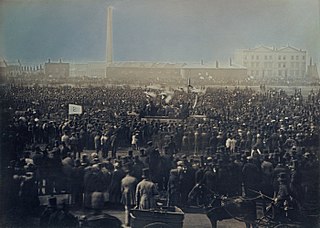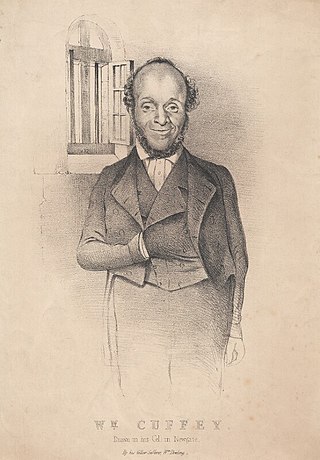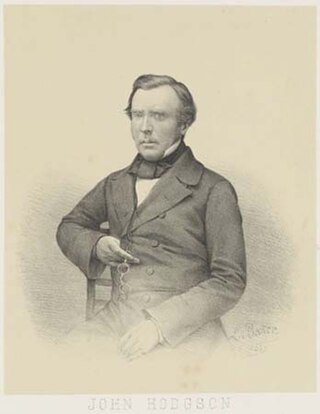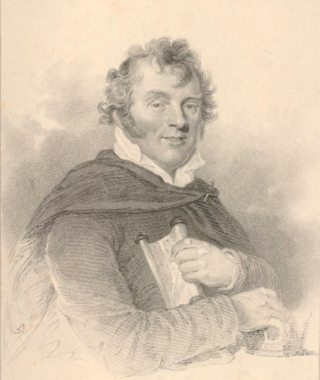Related Research Articles

The National Trust is a charity and membership organisation for heritage conservation in England, Wales and Northern Ireland. In Scotland, there is the separate and independent National Trust for Scotland.

Chartism was a working-class movement for political reform in the United Kingdom that erupted from 1838 to 1857 and was strongest in 1839, 1842 and 1848. It took its name from the People's Charter of 1838 and was a national protest movement, with particular strongholds of support in Northern England, the East Midlands, the Staffordshire Potteries, the Black Country and the South Wales Valleys, where working people depended on single industries and were subject to wild swings in economic activity. Chartism was less strong in places, such as Bristol, that had more diversified economies. The movement was fiercely opposed by government authorities, who finally suppressed it.

Feargus Edward O'Connor was an Irish Chartist leader and advocate of the Land Plan, which sought to provide smallholdings for the labouring classes. A highly charismatic figure, O'Connor was admired for his energy and oratory, but was criticised for alleged egotism. His newspaper Northern Star (1837–1852) was widely read among workers, becoming the voice of the Chartist movement.
The Land Acts were a series of measures to deal with the question of tenancy contracts and peasant proprietorship of land in Ireland in the nineteenth and twentieth centuries. Five such acts were introduced by the government of the United Kingdom between 1870 and 1909. Further acts were introduced by the governments of the Irish Free State after 1922 and more acts were passed for Northern Ireland.

William Cuffay was a Chartist leader in early Victorian London.

The Northern Star and Leeds General Advertiser was a chartist newspaper published in Britain between 1837 and 1852, and best known for advancing the reform issues articulated by proprietor Feargus O'Connor.

Minster Lovell is a village and civil parish on the River Windrush about 2+1⁄2 miles (4 km) west of Witney in Oxfordshire. The 2011 Census recorded the parish's population as 1,409. Minster Lovell village has three parts: Old Minster, Little Minster and New Minster. Old Minster includes the parish church, Minster Lovell Hall and the Old Swan Inn and Minster Mill Hotel. A large part of New Minster is the Charterville Allotments, which were founded by the Chartists in 1846–50.

Jesse Collings was Mayor of Birmingham, England, a Liberal member of Parliament, but was best known nationally in the UK as an advocate of educational reform and land reform.
Events from the year 1840 in the United Kingdom.

Dodford is a village in the Bromsgrove district of Worcestershire, England, approximately 3 miles (4.8 km) west of Bromsgrove, officially founded on 2 July 1849 by members of the Chartist movement. It was one of five settlements created in the land scheme and retains a characteristic grid street plan, along with narrow lanes and many plum and pear trees from its market gardening past. The civil parish of Dodford with Grafton has a population of 731.

Heronsgate is a settlement on the outskirts of Chorleywood, Hertfordshire founded by Feargus O'Connor and the Chartist Cooperative Land Company as O'Connorsville or O'Connorville in 1846.
The National Land Company was founded as the Chartist Co-operative Land Company in 1845 by the chartist Feargus O'Connor to help working-class people satisfy the landholding requirement to gain a vote in county seats in Great Britain. It was wound up by Act of Parliament by 1851.

Corse is a village in the English county of Gloucestershire, next to the village of Staunton. The parish lies on the tongue of land between the River Severn and the River Leadon. It is 6 miles north of Gloucester and 7 miles south-west of Tewkesbury.

John Hodgson was an Australian politician, member of the Victorian Legislative Council and Mayor of Melbourne 1853–54. He died at his house in Kew of bronchitis.

Dangan Castle is a former stately home in County Meath, Ireland, which is now in a state of ruin. It is situated by Dangan Church on the Trim Road. The castle is the former seat of the Wesley (Wellesley) family and is located outside the village of Summerhill. It was the childhood home of Field Marshal Arthur Wellesley, 1st Duke of Wellington.

Roger O'Connor (1762-1834) was an Irish nationalist and writer, known for the controversies surrounding his life and writings, notably his fanciful history of the Irish people, the Chronicles of Eri. He was the brother of the United Irishman Arthur O'Connor, and the father of the Chartist leader Feargus O'Connor and of Francisco Burdett O'Connor who was to fight in the Spanish American wars of independence.
Roderic O'Connor (1784–1860) was an Irish Australian landowner and public official, most notable for his activities as a land commissioner in Tasmania. He became one of the biggest landowners in Tasmania, and oversaw the modernisation of the land, typically using the forced labour of convicts.
Dodford Priory in the parish of Bromsgrove in Worcestershire in the current village of Dodford, was a small Augustinian monastery.
The British American Land Company (BALC) was a company formed in 1832 for the purpose of purchasing land and encouraging British immigration to Lower Canada. It was founded and promoted by John Galt, Edward Ellice and others to acquire and manage the development of almost 1,100,000 acres of Crown land and other lands in the Eastern Townships of Lower Canada, in order to encourage the immigration of British subjects to the region. In comparison to the Canada Company, a similar enterprise in Upper Canada that thrived through collaboration with the local government, the BALC indulged in land speculation, made immigration a secondary priority, and struggled throughout its existence.
Revenue Sale Law, 1793 was a British era law concerning collection of revenue from Bengal and as part of the Permanent Settlement agreement. The law changed allowed the auction of the land of Zamindars who could not pay taxes.
References
- 1 2 3 4 5 6 7 8 9 10 11 12 13 14 15 Hadfield, Alice Mary (2000) [1970]. The Chartist Land Company (2 ed.). Aylesbury: Square Edge Books. ISBN 0-7153-5809-X.
- 1 2 3 4 History Home
- ↑ chartists.net - List of those allocated land
- ↑ C. R. Elrington, ed. (1968). A History of the County of Gloucester. Victoria County History. Vol. 8. pp. 271–281. Retrieved 2009-03-07.